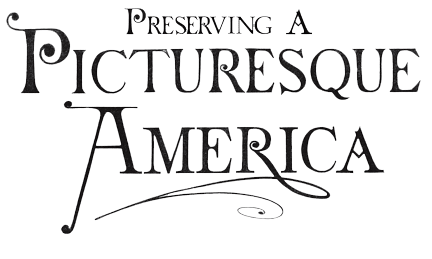![]()
Preservation Through Art: Artist Recreates Historic Travel Series
By WhitneyC Jun 4, 2018 Updated Sep 27, 2018
Over 145 years ago, American artists and writers contributed original artwork and captions to create a series of travel logs – entitled “Picturesque America” – which featured some of the most famous natural spaces and historic places in the continental United States, from the Yellowstone Valley in the West to the more local French Broad River.
As knowledge of, and access to, these places was limited – especially taking into consideration that the tourism industry had yet to blossom with the introduction of the Ford Model T – the series gave many people the opportunity to explore America by way of what we would equate to a coffee table book today.
“Picturesque America” introduced much of America to its beautiful natural spaces, and eventually played a role in promoting the importance of conservation and preservation in the mindset of the American people. Some of the first images that Congress saw of Yellowstone came from one of their artists, Thomas Moran, and after a relatively short deliberation, Congress sent the Act on to President Grant to sign, making Yellowstone the first of the now more than 60 National Parks.
Today, Asheville artist Scott Varn is working on a modern interpretation of the series by recruiting artists and writers nationwide to rediscover the spaces featured in the books, and recreate the original images from a modern viewpoint through the organization, Preserving A Picturesque America (PAPA).
“A few years ago, I was looking online at an estate auction for prints of this area and found a few engravings of the French Broad River,” said Varn. “When they arrived, I saw text written on the back side, and decided to research where the images had come from, which is how I discovered that they were part of this travel series called Picturesque America.”
In the spirit of the original series, Varn decided to work with artists and writers to illustrate the present state of the places featured – many of which have changed over the years. According to Varn, locally, there are 12 images of the French Broad River, alone, of which only 9 have been located by PAPA, to date.
“We are creating groups all over the country who are working to track down the locations of the images that are near them, and offer a modern interpretation of what those spaces look like today,” said Varn. “On the West Coast, some artists are creating interpretive dance, while here we have painters and photographers – we welcome any type of artist expression that celebrates these amazing spaces and seeks to preserve them in their community. For example, the French Broad images will be recreated by artists in Western North Carolina.”
The project not only works to visit and recreate images that feature these spaces, but a few local volunteers are actively working to preserve them. Boy Scout volunteers in Western North Carolina intend to Hot Springs to clean up Paint Rock – recognized as North Carolina’s best known example of an American Indian pictograph that dates to almost 5,000 years ago – and a space that was featured in Picturesque America.
Currently, the rock has been vandalized by spray paint, and the area is in need of cleaning up – as an extension of, and collaboration with PAPA, the troop’s work would be able to preserve Paint Rock for future generations to enjoy.
Varn also organizes events to seek out and interpret locations in Western North Carolina. Over the weekend, Varn had planned on hosting an artist’s retreat in Hot Springs, complete with group meals, and a hike to one of the locations from the series for the group and artists to recreate. The free retreat is currently being rescheduled due to the weather.
Overall, the intent of the project is to turn the project into a serial and then into a book, with the hope of using these recreated travel logs to contribute to movements that seek to conserve and protect these historic spaces.
To learn more about the project, or to become involved, please visit http://preservationthroughart.org or email Scott Varn at scott@preservationthroughart.org
